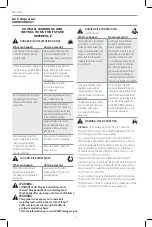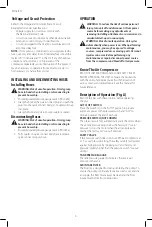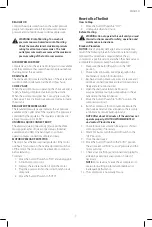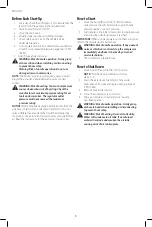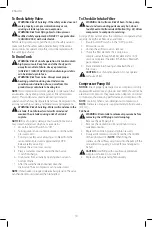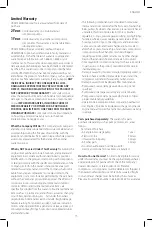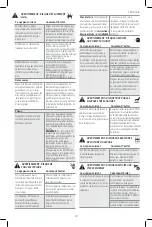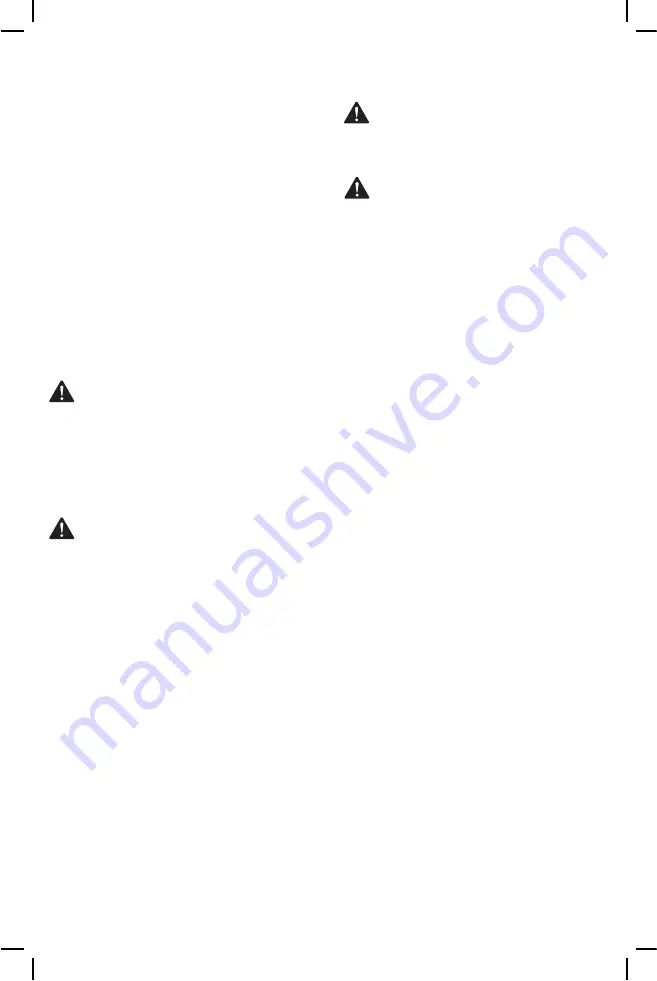
6
ENGLISH
Know The Air Compressor
READ THIS INSTRUCTION MANUAL AND SAFETY RULES
BEFORE OPERATING THE UNIT. Compare the illustrations
with the unit to familiarize yourself with the location of
various controls and adjustments. Save this manual for
future reference.
Description of Operation (Fig. A)
Become familiar with these controls before operating
the unit.
AUTO/ OFF SWITCH
Place this switch (1) in the "AUTO" position to provide
automatic power to the pressure switch and "OFF" to
remove power at the end of each use.
PRESSURE SWITCH (NOT SHOWN)
The pressure switch (2) automatically starts the motor when
the air tank pressure drops below the factory set "cut-in”
pressure. It stops the motor when the air tank pressure
reaches the factory set "cut-out" pressure.
SAFETY VALVE
If the pressure switch does not shut off the air compressor at
its “cut-out” pressure setting, the safety valve (3) will protect
against high pressure by “popping out” at its factory set
pressure (slightly higher than the pressure switch “cut-out”
setting).
TANK PRESSURE GAUGE
The tank pressure gauge (4) indicates the reserve air
pressure in the tank.
AIR INTAKE FILTER
The filter (6) is designed to clean air entering the pump. To
ensure the pump continually receives a clean, cool, and dry
air supply, the filter must always be clean and the filter
intake must be free from obstructions.
REGULATOR
Controls the air pressure shown on the outlet pressure
gauge. Turn regulator knob (18) clockwise to increase
pressure and counterclockwise to decrease pressure.
WARNING: Risk of Bursting. Too much air
pressure causes a hazardous risk of bursting.
Check the manufacturer’s maximum pressure
rating for ai tools and accessories. The tank
outlet pressure must never exceed the maximum
pressure rating of the tools or accessories.
AIR COMPRESSOR PUMP
Compresses air into the air tank. Working air is not available
until the compressor has raised the air tank pressure above
that required at the air outlet.
DRAIN VALVE
The drain valve (8) is located at the base of the air tank and
is used to drain condensation at the end of each use.
CHECK VALVE
When the air compressor is operating, the check valve (5) is
"open", allowing compressed air to enter the air tank.
When the air compressor reaches “cut-out” pressure, the
check valve "closes", allowing air pressure to remain inside
the air tank.
REGULATED PRESSURE GAUGE
The regulated pressure gauge indicates the air pressure
available at the outlet side of the regulator. This pressure is
controlled by the regulator. The regulator is designed to
allow pressures up to 150 PSI.
UNIVERSAL QUICK CONNECT BODY
The universal quick connect body (9) accepts the three
most popular styles of quick connect plugs: Industrial,
automotive, and ARO. One hand push-to-connect
operation makes connections simple and easy.
MOTOR OVERLOAD PROTECTOR
The motor has a thermal overload protector. If the motor
overheats for any reason, the overload protector will shut
off the motor. The motor must be allowed to cool down
before restarting.
To restart:
1. Move the Auto/Off switch to "OFF" and unplug unit.
2. Allow the motor to cool.
3. Depress the red reset button (10) on the motor.
4. Plug the power cord into the correct branch circuit
receptacle.
5. Move the Auto/Off switch to "AUTO".
INSTALLING AND DISCONNECTING HOSES
Installing Hoses
WARNING: Risk of unsafe operation. Firmly grasp
hose in hand when installing or disconnecting to
prevent hose whip.
1. Ensure regulated pressure gauge reads 0 PSI (0 kPa).
2. Grasp the hose at the quick connect plug and push the
plug into the quick connect body (L). Coupler will snap
into place.
3. Grasp the hose and pull to ensure coupler is seated.
Disconnecting Hoses
WARNING: Risk of unsafe operation. Firmly grasp
hose in hand when installing or disconnecting to
prevent hose whip.
1. Ensure regulated pressure gauge reads 0 PSI (0kPa).
2. Pull coupler on quick connect body back to release
quick connect plug on hose.
OPERATION
WARNING: To reduce the risk of serious personal
injury, turn unit off and disconnect it from power
source before making any adjustments or
removing/installing attachments or accessories. An
accidental start-up can cause injury.
WARNING: Risk of unsafe operation. Unit cycles
automatically when power is on. When performing
maintenance, you may be exposed to voltage
sources, compressed air, or moving parts. Personal
injuries can occur. Before performing any
maintenance or repair, disconnect power source
from the compressor and bleed off all air pressure.
Voltage and Circuit Protection
Refer to the Voltage and Minimum Branch Circuit
Requirements under Specifications.
• Voltage supply to circuit must comply with
the National Electrical Code.
• Circuit is not used to supply any other electrical needs.
• Extension cords comply with specifications.
• Circuit is equipped with a 15 amp circuit breaker or 15
amp time delay fuse.
NOTE:
If compressor is connected to a circuit protected by
fuses, use only time delay fuses. Time delay fuses should be
marked “D” in Canada and “T” in the US. If any of the above
conditions cannot be met, or if operation of the
compressor repeatedly causes interruption of the power, it
may be necessary to operate it from a 20 amp circuit. it is
not necessary to change the cord set.
How to Use The Unit
How to Stop
1. Move the Auto/Off switch to "OFF".
2. Unplug unit when not in use.
Before Starting
WARNING: Do not operate this unit until you read
this instruction manual for safety, operation and
maintenance instructions.
Break-in Procedure
NOTICE:
Risk of property damage. Serious damage may
result if the following break-in instructions are not closely
followed. This procedure is required before the air
compressor is put into service and when the check valve or
a complete compressor pump has been replaced.
1. Make sure the Auto/Off switch is in the "OFF"
position.
2. Check oil level in pump. See Oil paragraph in the
Maintenance section for instructions.
3. Recheck all wiring. Make sure wires are secure at all
terminals connections. Make sure all contacts move
freely and are not obstructed.
4. Open the drain valve fully to permit air to
escape and prevent air pressure build up in the air
tank during the break-in period.
5. Move the Auto/Off switch to "AUTO" position. The
compressor will start.
6. Run the compressor for 30 minutes. Make sure the
drain valve and all air lines are open so there is only
a minimal air pressure build-up in tank.
NOTE: After about 30 minutes, If the unit does not
operate properly, SHUT DOWN IMMEDIATELY,
and contact Product Service.
7. Check for excessive vibration. Re-adjust or shim air
compressor feet, if necessary.
8. After 30 minutes, turn the Auto/Off switch to the
"OFF" position.
9. Close the drain valve.
10. Move the Auto/Off switch to the "AUTO" position.
The air receiver will fill to “cut-out” pressure and the
motor will stop.
11. Check all air line fittings and connections/piping for
air leaks by applying a soap solution. Correct if
necessary.
NOTE:
Minor leaks can cause the air compressor to
overwork, resulting in premature breakdown or
inadequate performance.
12. The compressor is now ready for use.




